Realistic Girl Hair How to Draw Easy
Drawing hair or drawing hairstyles is less complicated than one thinks. The real challenge is in your patience and precision. However, the fundamental principle associated with drawing hair is quite simple. Drawing hair is simply a matter of strokes made with a pencil or pen. In this tutorial, we will be using both pen and pencil. This makes the process a little more challenging as we will have to have a lot of patience as we gently apply the strokes of the hair. When drawing hair, it is important to think about the nature of real hair, which is essentially a series of lines clumped together. This idea is what we want in the back of our heads as we go through this tutorial from start to finish.
Table of Contents
- 1 Necessary Materials
- 2 Preparation and Source Image
- 3 Step-by-Step Guide on How to Draw Hair
- 3.1 Step 1: Shaping the Hair Structure
- 3.2 Step 2: Shading the Left Locks
- 3.3 Step 3: Shading the Right Locks
- 3.4 Step 4: Add On Effects
- 4 Tips to Remember
- 5 Frequently Asked Questions
- 5.1 How to Draw Realistic Hair?
- 5.2 How Do I Draw Female Hair?
- 5.3 How Do I Draw Wavy Hair?
- 5.4 How to Shade Hair?
Necessary Materials
We will be using graphite pencils and pens. Pencils are helpful for hair drawing as they provide us with a template-like mark-making process which we will then apply pen over to bring our drawing to life. Using a pen as a drawing medium can mimic the realistic contrast qualities that we see in anatomical structures. We use the pen as a way to bring the drawing out and make it pop.
- A full set of pencils
- An eraser
- A sharpener
- A ballpoint pen
- Good paper
- Source material
Preparation and Source Image
For our hair drawing reference, we will be using an image of a female as her hair provides us with a unique challenge. The curls and brunette coloring of her hair have various tonal values that sit on the tonal spectrum between dark and light. With all our materials ready we can now begin our hair drawing process.
We have our pencils sharpened and our eraser, sharpener, and a full range of pencils ready for use. We should also have our source image next to us and our drawing station in a well-lit room. With all that being said it is time to draw.
Step-by-Step Guide on How to Draw Hair
In this tutorial, we will be doing a hair drawing. With hair drawing, we want to develop the skill of how to shade hair. There are various hairstyle drawings one can do when learning how to draw hair, in this tutorial we will be doing a female curly hairstyle drawing.
For our hair drawing reference, we will be using an image that we can either print or refer to directly from a smart device.
Drawing hairstyles is a great exercise for developing a general profile drawing skill. As we go through the various steps leading to the part of shading we will also learn how to develop the general skills of hair shading with a pen.
Step 1: Shaping the Hair Structure
Let us begin with shaping the hair structure. We do this by taking our H pencil and drawing a circle that defines the size of the head of the figure in your source image.
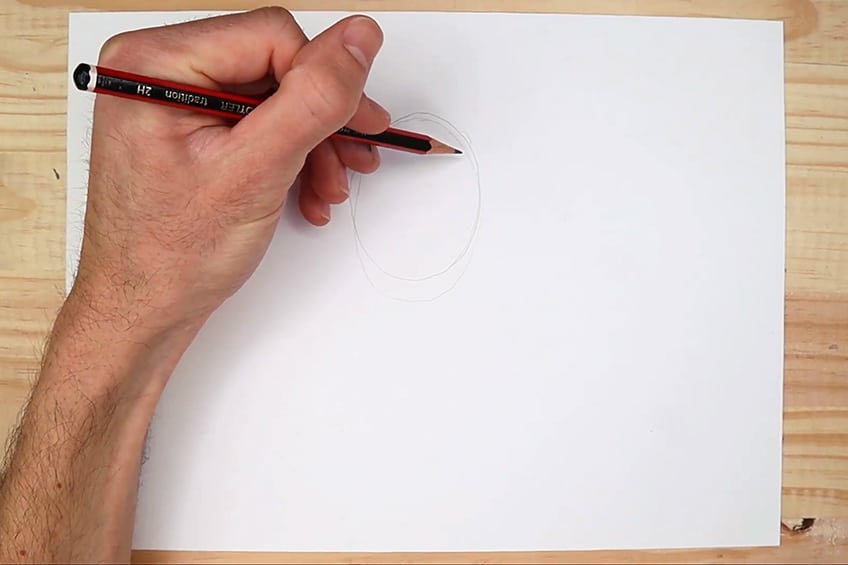 We want to slowly turn this circle shape into a head structure that resembles the outline of the figure's head in the source image. As we consolidate the shape of the head we can begin to draw the hair with our H pencils.
We want to slowly turn this circle shape into a head structure that resembles the outline of the figure's head in the source image. As we consolidate the shape of the head we can begin to draw the hair with our H pencils.
What we want to do is very loosely draw the shape of the hair outline whilst we use our source image as a guide for accuracy.
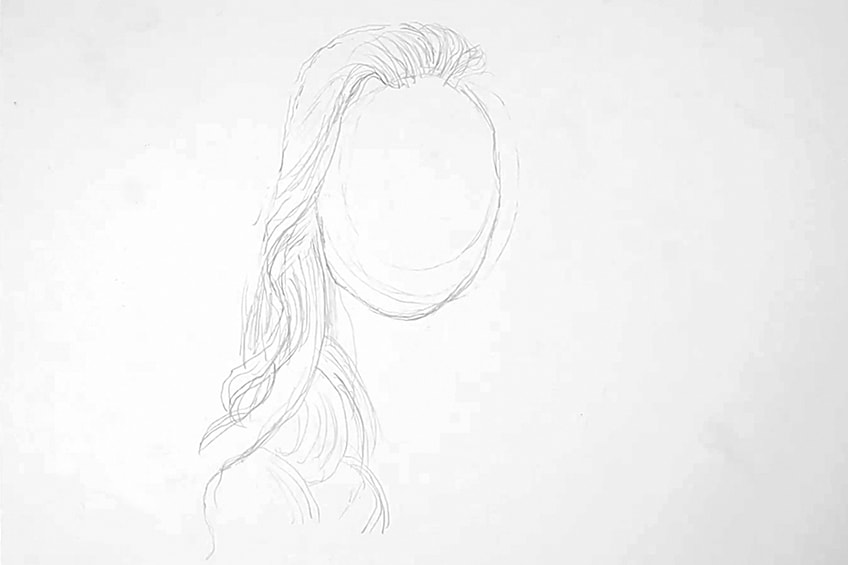 As we draw the hair structure we can zoom into our source image and see how there are large portions in the hair that break the full body of hair into various segments. With your pencil slowly and cautiously draw these various lines as you go. Remember, the action is an application of various lines.
As we draw the hair structure we can zoom into our source image and see how there are large portions in the hair that break the full body of hair into various segments. With your pencil slowly and cautiously draw these various lines as you go. Remember, the action is an application of various lines.
 As we look at our source image consider the areas of the hair that define a contrast between its lightest and darkest moments. Learning how to draw realistic hair requires attention to shape, you want to take time with this step. When we draw hair there is a quality of divisions or segments that we are usually drawing in the whole body.
As we look at our source image consider the areas of the hair that define a contrast between its lightest and darkest moments. Learning how to draw realistic hair requires attention to shape, you want to take time with this step. When we draw hair there is a quality of divisions or segments that we are usually drawing in the whole body.
These segments, within the source image, are broken up by the shadows in the hair.
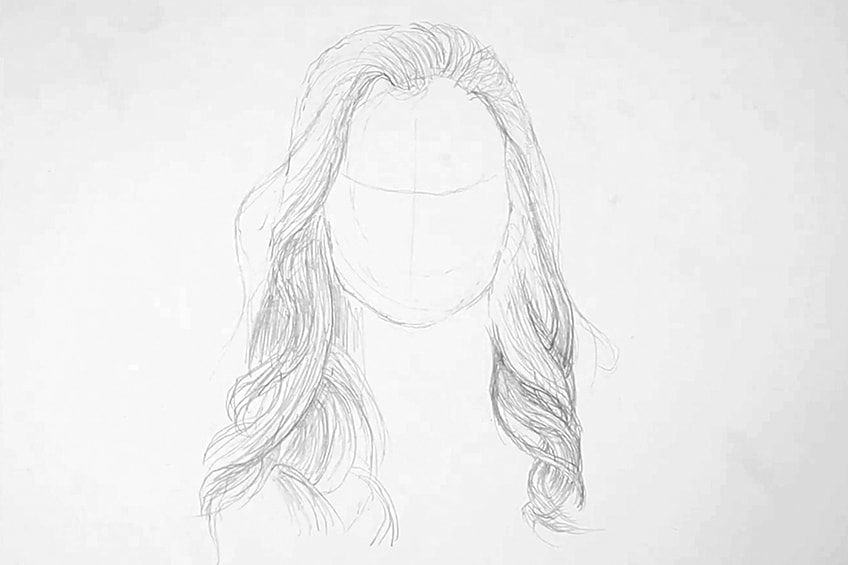 As you draw the hair, remember that we want to mimic the quality of real hair which is generally a series of fine lines clumped together. These different clumps are the segments that I am referring to. As we will begin to draw with a pen we are going to follow our pencil marks as fine and gentle as possible and add moments of shading as we go.
As you draw the hair, remember that we want to mimic the quality of real hair which is generally a series of fine lines clumped together. These different clumps are the segments that I am referring to. As we will begin to draw with a pen we are going to follow our pencil marks as fine and gentle as possible and add moments of shading as we go.
Hair shading is tricky and is an important part to grasp when learning how to draw realistic hair.
Step 2: Shading the Left Locks
Before we begin to draw and shade with a pen, take a moment to analyze your source image again. Consider the various shadows within the hair. We can see that shadowing is formed in little areas that seem to be inside of the hair as if you can see through the first layer of hair. Then there are moments when the hair is densely compact which prevents us from looking through the hair.
This will develop a sense of lightness or shine as the light has something to deflect off of. With your ballpoint pen, we will begin to shade the areas where we can see the shadow.
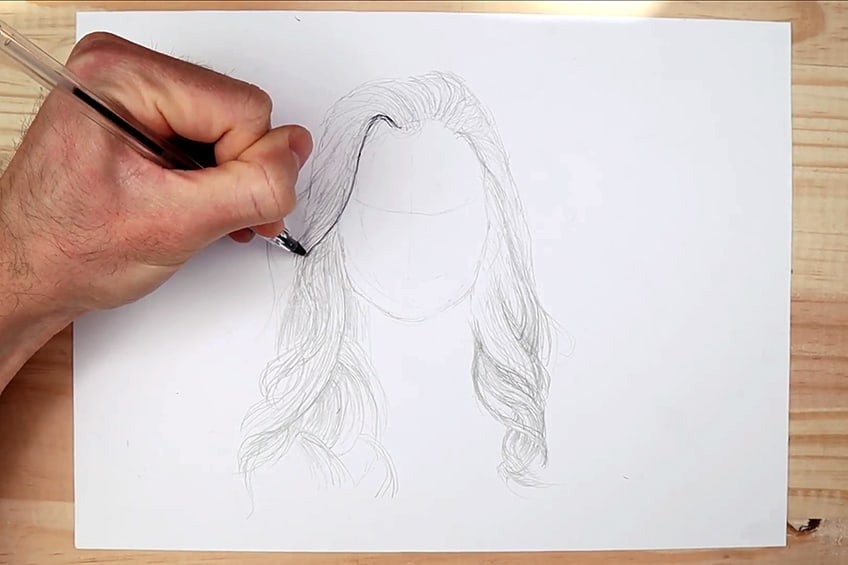 As we learn how to shade hair with a pen we want to be patient. We don't want to shade all of the hair at once but with a great sense of caution and consideration of our source image, we can begin to slowly apply these marks. Allow your pencil marks to guide you as you refer to your source image as well. Remember that hair is just a series of lines clumped together flowing in a particular direction. So keep your pen strokes flowing in the direction that the hair falls naturally.
As we learn how to shade hair with a pen we want to be patient. We don't want to shade all of the hair at once but with a great sense of caution and consideration of our source image, we can begin to slowly apply these marks. Allow your pencil marks to guide you as you refer to your source image as well. Remember that hair is just a series of lines clumped together flowing in a particular direction. So keep your pen strokes flowing in the direction that the hair falls naturally.
Again, try to notice the overlapping moments where the hair is clumped together and has a wave-like motion over another section that develops underneath it.
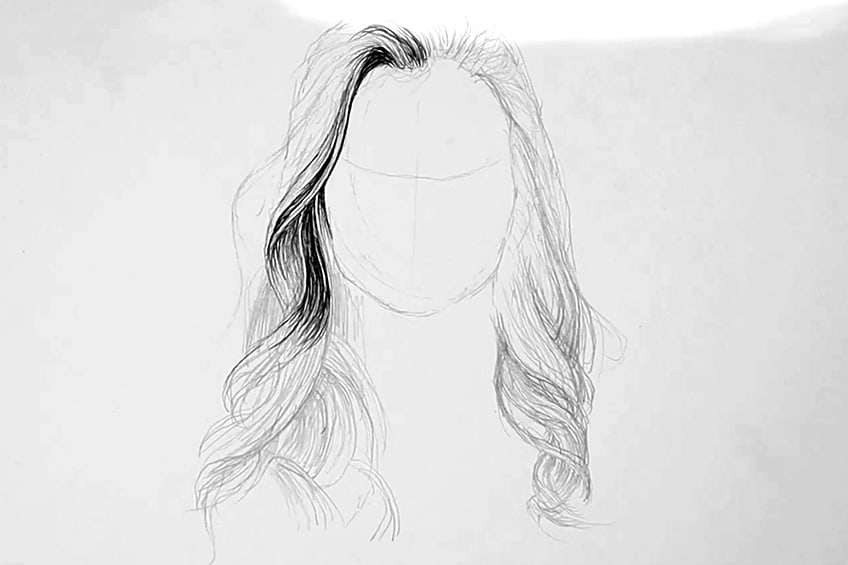 What we want to do is slowly apply these lines with our pen as we refer to our source image. However, as we go through each section imagine how different aspects of the hair are exposed to light. For instance, there is less light visible during the overlapping moments.
What we want to do is slowly apply these lines with our pen as we refer to our source image. However, as we go through each section imagine how different aspects of the hair are exposed to light. For instance, there is less light visible during the overlapping moments.
These are generally the darker moments.
As the hair comes out of each overlapping moment it becomes lighter again and slowly flows into another moment of the hair grouping. Keep in mind the action we are using with our pen is light strokes with moments of harder strokes as we come to the shadowy areas.
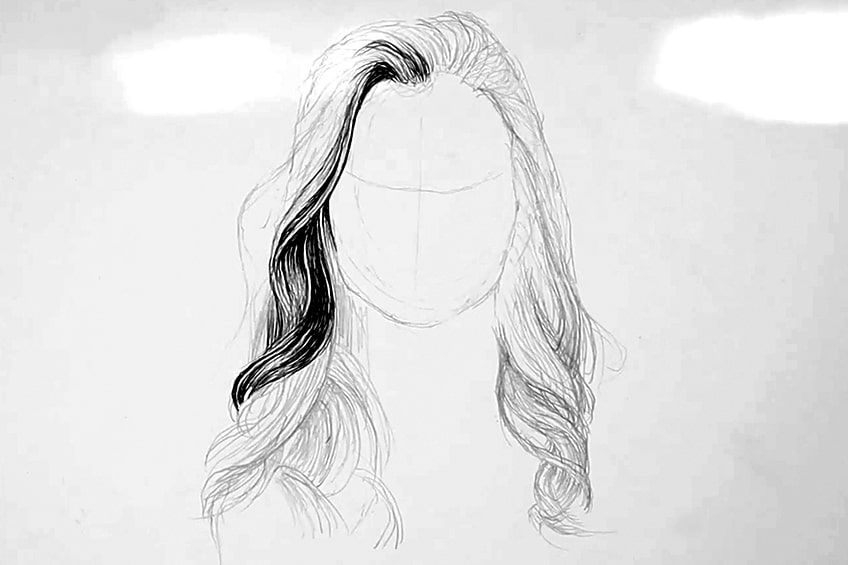 Figuring out how to shade the hair with a pen is quite a simple procedure which means it can feel repetitive at some point. A good suggestion is to take a break, have a moment of rest, and then come back to the drawing with a refreshed mindset.
Figuring out how to shade the hair with a pen is quite a simple procedure which means it can feel repetitive at some point. A good suggestion is to take a break, have a moment of rest, and then come back to the drawing with a refreshed mindset.
Taking a break gives us a fresh perspective which will help with the process.
This action of light strokes with a gentle hand is the aim of the shading process done with a pen. When learning how to draw realistic hair with a pen it is essential to understand the various pressures applied to the pen for various tones. Light hand for lighter tones and more pressure for darker strokes.
 That being said, there are a few moments in the hair where the lines become thick and then thin again as a way of showing that the hair has depth with various layers of hair behind the layers that fall in front. This action should be a harder press of the pen.
That being said, there are a few moments in the hair where the lines become thick and then thin again as a way of showing that the hair has depth with various layers of hair behind the layers that fall in front. This action should be a harder press of the pen.
The action should be guided by the source image's depiction of shadowing in the hair.
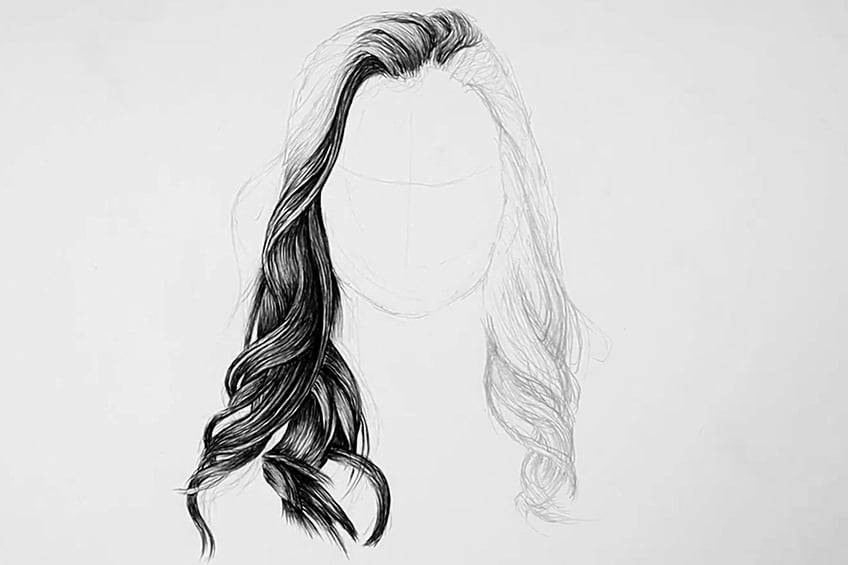 As we focus on the tips of the hair if the hair is damaged the ends generally split. However, the hair naturally does split in various directions, with moments of it being in a straight cut. What we want to do is achieve a variety of these qualities with both a stroke of the hand for the splits and a gentle drawing of lines to a point for the straight-cut moments.
As we focus on the tips of the hair if the hair is damaged the ends generally split. However, the hair naturally does split in various directions, with moments of it being in a straight cut. What we want to do is achieve a variety of these qualities with both a stroke of the hand for the splits and a gentle drawing of lines to a point for the straight-cut moments.
Drawing hairstyles require an emphasis on these little details.
Step 3: Shading the Right Locks
Let us shift our focus to the hair on the top of the head as we transition to the right side of the hair. We want to analyze the source image and see how the hairs sprout outwardly from the top of the head toward the left and right directions towards where the hair falls.
 As we analyze our source image a good idea is to begin shading under the hair where it would create shadows. This shadowing area gives the idea of volume in the hair as the hair's density can cast shadows. We can be a bit harder with our strokes for these moments.
As we analyze our source image a good idea is to begin shading under the hair where it would create shadows. This shadowing area gives the idea of volume in the hair as the hair's density can cast shadows. We can be a bit harder with our strokes for these moments.
These details help us with learning how to draw hair more correctly.
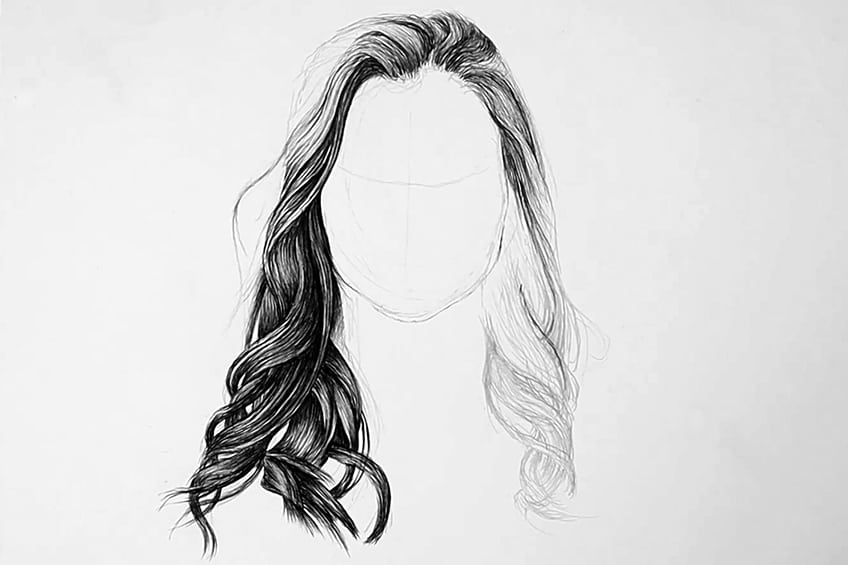 Then we want to slowly and gently begin to apply the soft lines with our pens as mentioned previously. These are soft and long strokes moving along the pencil marks. We can also keep referring to our source image for reference to guide us.
Then we want to slowly and gently begin to apply the soft lines with our pens as mentioned previously. These are soft and long strokes moving along the pencil marks. We can also keep referring to our source image for reference to guide us.
We can keep doing this until we come to the moments of overlapping. Remember that the hair generally is exposed to light until it overlaps with other clumps of hair. These are the moments when our strokes become harder.
These areas create a lot of shadows.
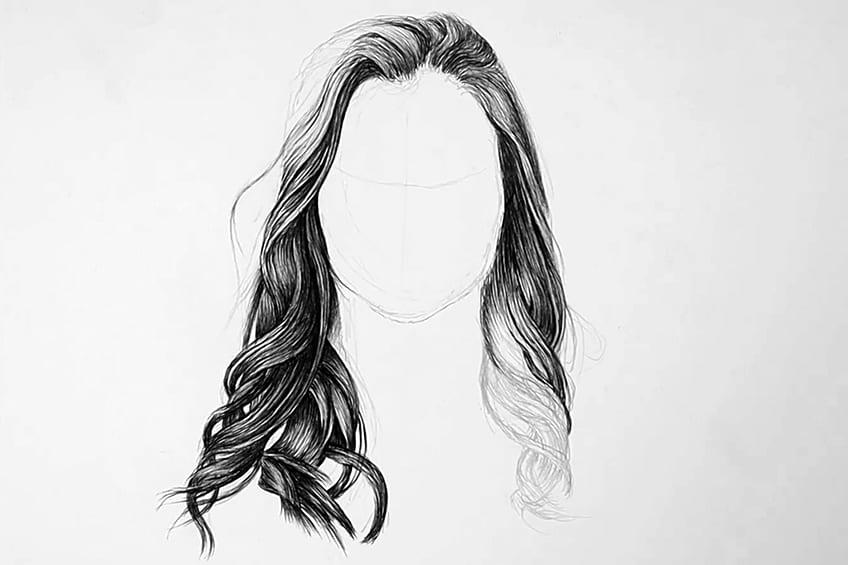 As we come to the lower area of the locks we want to pay attention to the different moments where the hair intertwines. Spend some time looking at your source image as you go back and forth between your image and drawing slowly applying marks with your pen As we learn how to draw hair we want to make sure we are following the direction of the hair and the way it falls. The hair has a twist-like motion as it coils near its ends.
As we come to the lower area of the locks we want to pay attention to the different moments where the hair intertwines. Spend some time looking at your source image as you go back and forth between your image and drawing slowly applying marks with your pen As we learn how to draw hair we want to make sure we are following the direction of the hair and the way it falls. The hair has a twist-like motion as it coils near its ends.
Make sure you take note of this quality on the hair within the source image as you draw.
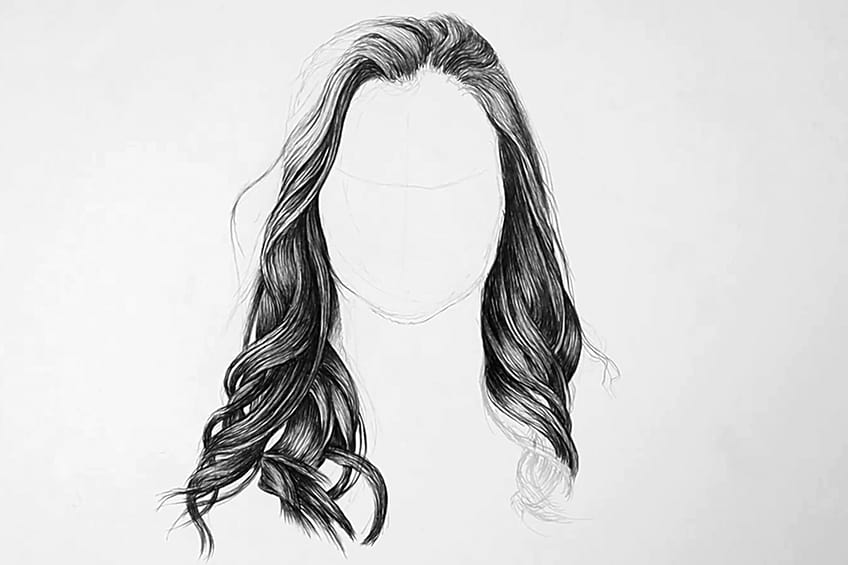 We want to slowly and patiently draw these lines in a twisting action. This gentle twisting action is what gives the effect of curls. However, make sure that as you draw these twists we want to apply a little more pressure to our strokes.
We want to slowly and patiently draw these lines in a twisting action. This gentle twisting action is what gives the effect of curls. However, make sure that as you draw these twists we want to apply a little more pressure to our strokes.
You should apply pressure near the areas of the hair where they overlap.
It is important to note that these overlapping moments create shadows which means we press harder to create that effect. However, we want to soften the pressure every time we draw the hairs coming out of a moment of overlapping. Think of it as softening the pressure to create a fading effect
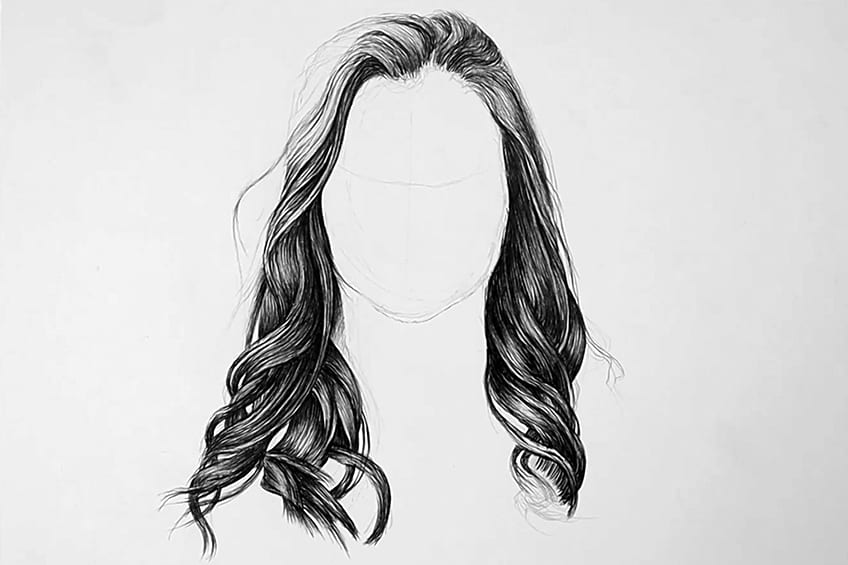 We can slowly and gently carry on this process of making soft line strokes following the twists of the hair. Always go back and forth between your drawing and source image to keep the resemblance as accurate as possible. Slowly work your way to the tips of the hair and try to take note of how the hairs both split and are clumped in a straight cut near the tips.
We can slowly and gently carry on this process of making soft line strokes following the twists of the hair. Always go back and forth between your drawing and source image to keep the resemblance as accurate as possible. Slowly work your way to the tips of the hair and try to take note of how the hairs both split and are clumped in a straight cut near the tips.
The duality of this gives the quality of how real hair sits naturally.
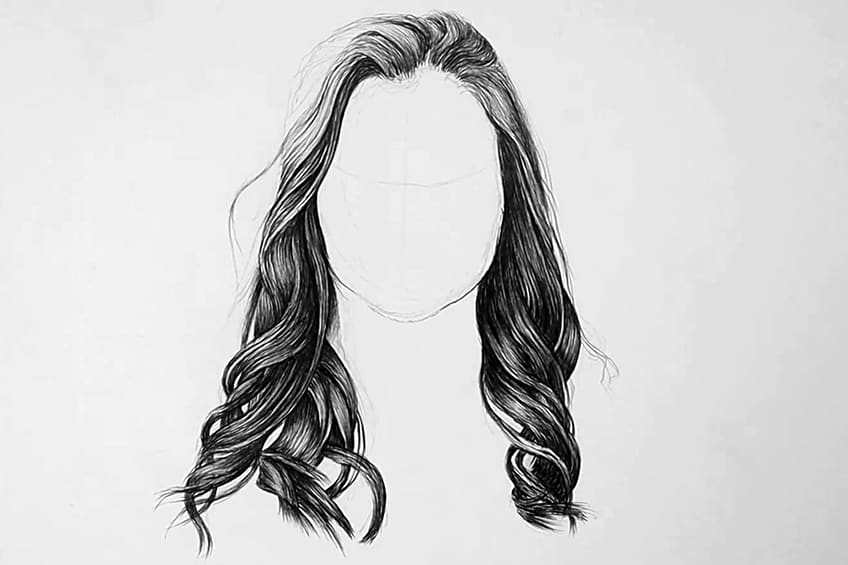
Step 4: Add On Effects
What we want to do now is go over our source image and take note of all the little wispy hairs around the head. These little rogue hairs can be drawn very lightly with our pens. This is a great way to give off the quality of how hair acts naturally.
 Another add-on effect is to go to the light areas of the hair and add in a little more details. This tutorial shows that the left side of the head is where its lightest moments are, so a good suggestion is to carefully apply some dark strokes.
Another add-on effect is to go to the light areas of the hair and add in a little more details. This tutorial shows that the left side of the head is where its lightest moments are, so a good suggestion is to carefully apply some dark strokes.
This will create the effect of volume.
 We can do this by adding in short hard strokes from the outside of the hair outline moving inward. This way it gives the effect of the hair getting darker where it would wrap around the back of the hair which would be less exposed to light.
We can do this by adding in short hard strokes from the outside of the hair outline moving inward. This way it gives the effect of the hair getting darker where it would wrap around the back of the hair which would be less exposed to light.
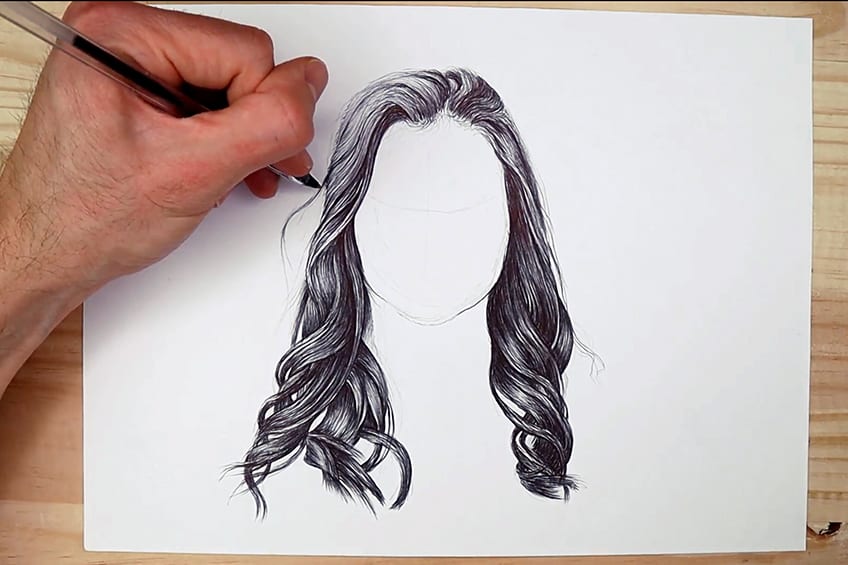 We can also define these little moments of detail near the top of the head from where the hairs sprout. Generally, these darker moments are found in the parting line of the hair. So we can begin to make dark strokes with our pens.
We can also define these little moments of detail near the top of the head from where the hairs sprout. Generally, these darker moments are found in the parting line of the hair. So we can begin to make dark strokes with our pens.
Do this from the middle part of the hair.
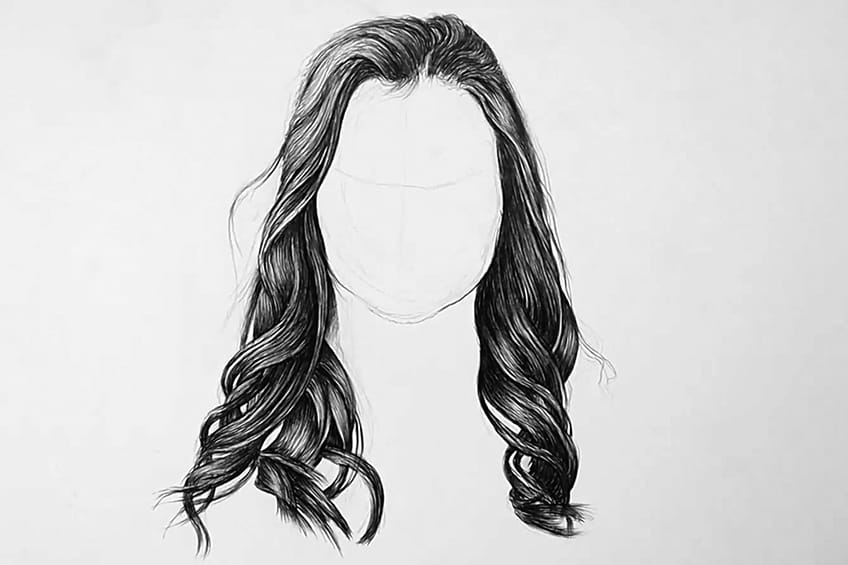 We can also put some slight shadowing around the neck as we use our source image for guidance. This helps to create a sense of depth under the hair and gives off the impression of how the hair falls onto the shoulders.
We can also put some slight shadowing around the neck as we use our source image for guidance. This helps to create a sense of depth under the hair and gives off the impression of how the hair falls onto the shoulders.
 When learning how to draw hair, we want to make sure we take one last look at our drawings and compare them to the source image. Go over your drawing and add in little strokes here and there that you feel might be necessary.
When learning how to draw hair, we want to make sure we take one last look at our drawings and compare them to the source image. Go over your drawing and add in little strokes here and there that you feel might be necessary.
There you have it, how to draw hair in a few simple steps!
Tips to Remember
- Learning how to draw hair, especially learning how to draw realistic hair, requires attention to details and how they are defined in a reference image.
- This drawing is really about taking your time. If you find yourself feeling tired, don't compromise your drawing, just take a break.
- When drawing hair with a pen, you always want to keep your strokes soft and light. And then slowly develop the darker moments of shading on top of the light lines.
- Try to fully develop the drawing with a pencil before you begin shading in with a pen where the hair should be light in the areas you want to attend to last. Generally, it is about working around the negative area with a pen to keep the effect of light.
- Always refer to your source image as you slowly work through the whole head of hair.
- Take time analyzing the source image for a better understanding of how to shade hair.
As we draw hair it is always important to keep in mind that the process is to mimic the actual quality of hair. When we think of hair, what it is is a series of lines compiled into groups that can be wavy, coily, straight, and so on. When these groupings merge or overlap, there is always a sense of shadowing that develops as an effect of that overlapping. This is where we slowly shade and add in darker tones. Another important aspect to remember is that in the light moments of the hair the lines are thick and thin. This creates the effect of depth. So, there are a few things that can make the hair look realistic but the fundamental principle is that we are drawing a series of lines moving in a particular direction.
Frequently Asked Questions
How to Draw Realistic Hair?
Learning how to draw realistic hair is about realizing what hair actually is. Hair is a series of fine lines that move in a particular direction. However, that motion can change which is what we see in curly hair. Depending on what kind of hair you want to draw, you want to observe that particular kind of hair in real life. What you will notice is that the real hair is a series of lines that are clumped together and when overlapping creates shadowing. The aim is to draw a series of lines in segments that can be divided by the moments of overlap in the hair. We draw the overlap by shading in these areas which are produced from a line that generally runs through a series of lines going in a single direction.
How Do I Draw Female Hair?
Learning how to draw hair or more specifically drawing female hair is a tricky task because all hair is different. However, when we draw straight hair, our lines have slight curves. When we draw wavy hair, such as in this tutorial, we draw hair that has a twisting motion. The point is that we need to analyze the source image of the hair we draw and then apply the principles of lines to the shape. The best idea is to do an outline of the hair and then slowly apply lines in the different hair segments or shapes in the hair. Then we shade the hair where there are overlapping moments or intertwined moments to give the hair a sense of volume.
How Do I Draw Wavy Hair?
Understanding different hair structures are essential to understanding the process of hair drawing. For wavy hair, the hairs generally have a twisting motion in them near the bottom and a bumpy motion near the top. Because the wavy hair of females can be heavy the top might seem slightly less bumpy. However, as the hair comes to the ends and tips they begin to move in various directions twisting in and around each other. The goal here is to get the outline of the shape correct and then slowly begin to add your lines and shades in the overlapping moments.
How to Shade Hair?
Learning how to shade hair for particular hairstyles drawing is tricky. It starts with understanding the overlaps of different types of hair. When we draw curly hair we approach hair shading by seeing how shadows are produced in curly hair in real life. The shadows are formed mostly by the moments where hair twists or overlaps. This is something to concentrate on with real hair to really grasp how the process of shading hair. As a rule of thumb, we should always try to develop the hair lines and then either shade over or in between them. This is the general guiding principle associated with learning how to shade hair.
whiteheadanat1980.blogspot.com
Source: https://artincontext.org/how-to-draw-hair/
0 Response to "Realistic Girl Hair How to Draw Easy"
Post a Comment